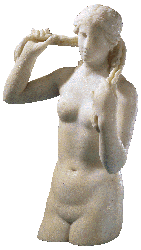 |
Marble Statuette of Aphrodite
Click on image for interactive viewing.
ca. 150-100 BC
Benghazi, eastern Libya
69-14-1
The goddess rises nude out of the sea which gave her birth, wringing the
sea water from her hair. The statuette may have been intended for display
in a pool of water, since it appears to have been cut off at the waist
as part of its original design. Aphrodite is goddess of sexuality and
erotic love, and concerned with fertility and procreation. She was also
worshipped as a goddess of the sea. Embodying perfect beauty, she appears
clothed in the major arts until the 4th century BC when her statues show
her naked.
H. 32.0; L. 21.0; W. 13.5 cm. Photo courtesy Public Information Office,
Univ. of Pennsylvania Museum. (83k) |
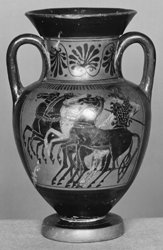
|
Attic Black Figure Amphora
Early 5th century BC
By the Diosphos Painter
On loan, Philadelphia Museum of Art
L-64-177
The goddess Athena driving a four-horse chariot or quadriga.
H. 18.8; Dia. 12.0 cm. UM neg. S8-2828. (215k) |

|
Silver Tetradrachm
ca. 449-410 BC
Athens
29-126-404
The head of Athena is on the obverse, an owl with olive branch on the
reverse. The goddess (in Greek, Athena) is a punning reference to the
city (in Greek, Athenai) that honored her as its chief protective deity.
The owl as Athena's favorite bird and the olive, which was one of the
city's most lucrative exports, came in time to stand for Athens throughout
the Mediterranean world.
Dia. 24.0 mm. Obverse: Photo courtesy Registrar's Office, Univ. of Pennsylvania
Museum.
Reverse: Photo courtesy Donald White. (100k) |

|
Marble Head of Athena
2nd century BC
Purchased in Cairo
MS 4026
Athena was the daughter of Zeus and originally a Mycenaean palace goddess.
Her function later expanded to include the roles of guardian of cities,
war goddess, patroness of arts and crafts, and promoter of wisdom. She
is always shown modestly clothed and often armed. The owl is her special
bird. The back of the sculpture seems deliberately cut and at least one
rectangular hole looks ancient. This suggests that the head once formed
part of a relief. Given its size, the unfinished appearance of the top
of the helmet, and the foreshortening evident in its execution, the head
may have been part of a sculpted pediment group, perhaps originally set
up in Alexandria.
H. 30.0; W. 24.0; Th. 16.0 cm. Photo courtesy Mediterranean Section, Univ.
of Pennsylvania Museum. (66k) |
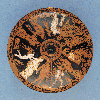
|
Attic Red Figure Pyxis
ca. 400-390 BC
By the Meleager Painter
MS 5462
Heracles and Hebe's wedding in the presence of the gods on Mt. Olympus.
The lid of the pyxis shows Heracles leading Hebe to his house, while an
Eros or Cupid figure carries a marriage torch in front of the wedded couple.
Hebe is dressed in a white and gold chiton and himation and wears a wedding
veil which another Eros adjusts. A goddess lights the scene with a pair
of torches. Athena and Zeus sit enthroned, while Hera leans intimately
against Zeus's shoulder. A third Eros reclines against Zeus's throne next
to a high-stemmed censer for burning incense. Behind the Eros is a low,
footed chest, probably a wedding gift. Two women carry a jewel box for
the bride and a vessel containing water for her bridal bath.
H. 9.0; Dia. 21.8 cm. Photo courtesy Public Information Office, Univ.
of Pennsylvania Museum. (165k) |
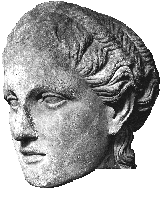
|
Over Life-size Marble Head of a Goddess
2nd century BC
30-7-1
The detached, serene expression, frontal gaze, and over life-size scale
of this head, which in other respects recalls the style of the Messenian
sculptor Damophon, all suggest that it may have belonged to an actual
cult statue. Too little survives of the complete statue to be totally
certain of its original purpose or to suggest which goddess is specifically
being represented.
H. 42.0; Dia. 31.5 cm. UM neg. 140075. (231k) |

|
South Italian Greek Terracotta Votive Figurine
ca. 450-425 BC
MS 1857
Either a Demeter or Persephone figurine or a priestess. The low polos
headdress is associated with both, but the apron suggests a priestess.
Carrying a piglet, she holds aloft a circular box or kanoun. Inexpensive
terracottas depicting female subjects turn up in very large quantities
in sanctuaries dedicated to female goddesses throughout the Greek world.
Women were especially active in all aspects of Demeter's cult.
H. 32.5; W. 13.0; Th. 8.0 cm. UM neg. S8-55808. (99k) |

|
Attic Black Figure Amphora
ca. 530-525 BC
In the manner of the Lysippides Painter
MS 5467
Both sides portray scenes of mythological battle, which symbolize the
Greek preoccupation with struggle as well as their love for detailed battle
narrations. Such scenes are a hallmark of Archaic art. Here, Heracles
(at the left) fights with two Amazons, a race of female warriors thought
to live on the fringes of the civilized world.
H. 41.0; Dia. 28.0 cm. Photo by Maria Daniels for the Perseus Project.
(132k) |
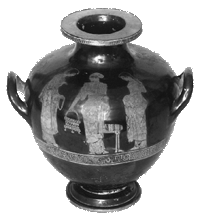
|
Attic Red Figure Hydria
ca. 460-450 BC
By the Penthesileia Painter
On loan, Philadelphia Museum of Art
L-64-41
A matron, joined by her young daughter and short-haired servant, holds
a three-legged basket or situla. Behind is a stool with a woven cushion.
The items most commonly illustrated on vases and on stone reliefs include
chairs, stools, couches, tables and various kinds of chests, boxes and
baskets. Since these were originally largely made of wood and other organic
materials, their survival tends to be poor, but specimens of Greek furniture
have been found in tombs.
H. 24.7; L. 25.0; Dia. 20.0 cm. UM neg. S4-95090-94. (165k) |
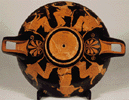
|
Attic Red Figure Kylix
ca. 480-470 BC
By the Painter of Philadelphia 2449 and the potter Hieron
Chiusi, Italy
MS 2449
A scene from the women's quarter or gynaikonitis. Women talk while sitting
on chairs. Two play the aulos (double reed instrument) and krotala (rattle).
A standing woman holds a mirror. On the interior, an elegant woman, holding
a box, lifts the lid of an inlaid chest.
H. 8.7; L. 29.8; Dia. 23.3 cm. Photos by Maria Daniels for the Perseus
Project. (132k) |
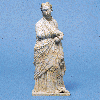
|
Terracotta Figurine
Early 3rd century BC
MS 5679
Standing clothed female figure of possibly Corinthian manufacture, wearing
a himation over a floor-length chiton. The himation was a rectangle of
wool or linen, often drawn away from one shoulder. The figure's earrings
are well preserved. Traces of white slip cover most of the figure, and
rusty red survives in the hair.
H. 20.7; W. 7.6; Th. 5.0 cm. Photo courtesy Public Information Office,
Univ. of Pennsylvania Museum. (99k) |

|
Italic Low-Footed Red Figure Bowl with High Handles
4th century BC
On loan, Philadelphia Museum of Art
L-64-23 detail
The most common toilet article appearing on vases is the mirror, usually
made of polished silver or bronze. These and a wide variety of cosmetic
implements are often excavated in tombs, sanctuaries dedicated to female
divinities, and in the domestic quarters of ancient towns.
Photo courtesy Mediterranean Section, Univ. of Pennsylvania Museum. (99k) |
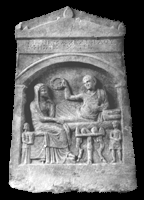 |
Western Asia Minor Marble Funeral Stele
Hellenistic/1st century BC
MS 4023
A man reclines in an arched niche on a tall dining couch or kline. Leaning
on his left elbow supported by a pillow, he holds aloft a funeral wreath.
A woman, probably his wife, is shown in an attitude of contemplation with
her cloak or himation pulled over her head. The three-legged table is
laden with food. Male and female servants, done in a smaller scale in
keeping with their lesser status, fill out the remainder of this melancholy
scene. The inscription across the architrave reads "Worthy Menemachos,
son of Diphilos, farewell."
H. 70.5; W. 47.0; Th. 8.5 cm. UM neg. NC35-3317. (231k) |

|
Attic White Ground Lekythos
Late 5th century BC
Attica
MS 4082
A girl seated on a chair with a wreath in her hands; her wool basket is
set to the right. The undulating snake, which appears above, is traditionally
associated with the dead from the Geometric period on.
H. 13.4; Dia. 5.0 cm. Photo by Maria Daniels for the Perseus Project.
(132k) |

|
Attic White Ground Lekythos
Late 5th century BC
By the Reed Painter
On loan, Philadelphia Museum of Art
L-64-144
A man and a woman flank a grave stele. Because the colors were added after
firing and were based on unstable pigments that tended to flake away,
White Ground scenes often survive in poor condition and their figures
appear naked where they were originally intended to look dressed.
H. 24.0; Dia. 8.0 cm. UM neg. S8-120633. (99k) |



